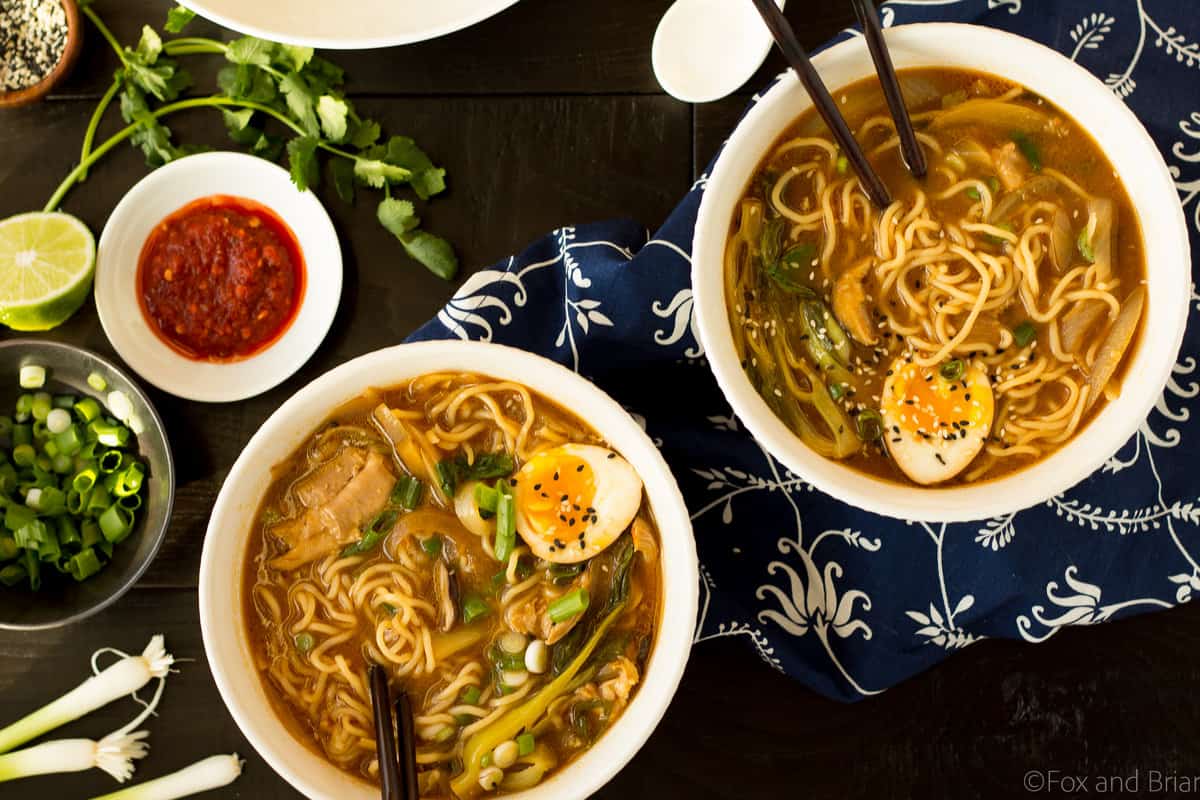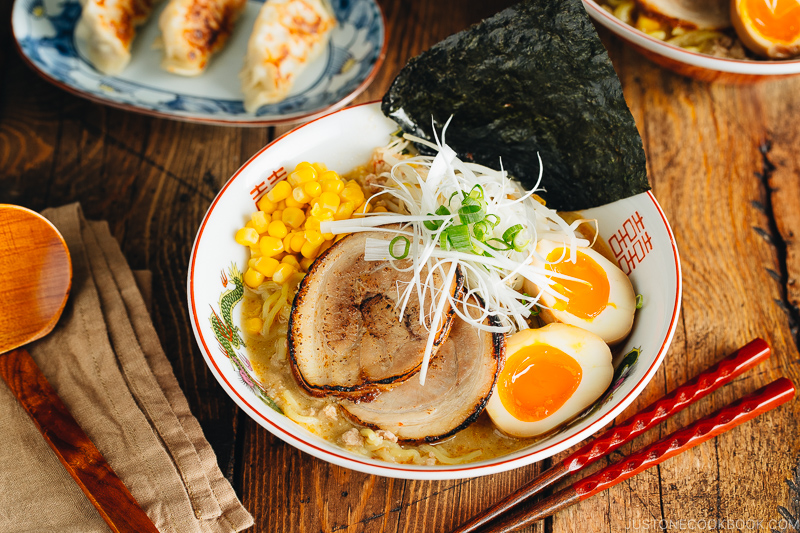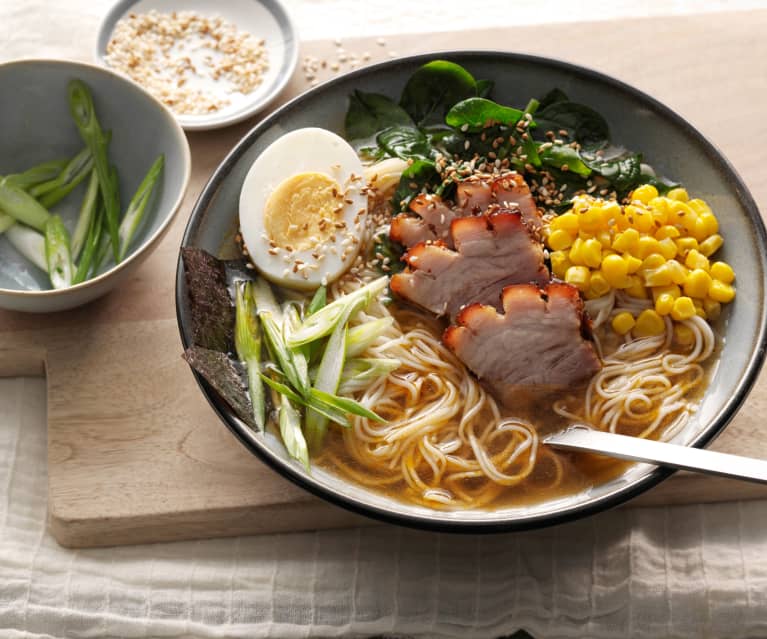The Japanese Chicken Ramen with Bok Choy and Soy Eggs recipe combines the comforting flavors of chicken, bok choy, and soy-marinated eggs in a delicious and satisfying bowl of ramen. This recipe offers a balanced and nourishing meal, with tender chicken slices, vibrant bok choy, and savory soy-marinated eggs. The broth is infused with aromatic ingredients like ginger, garlic, and soy sauce, creating a rich and flavorful base. To assemble the ramen, cook the noodles according to package instructions, blanch the bok choy, and prepare the soy-marinated eggs. Ladle the fragrant broth over the noodles and arrange the chicken, bok choy, and eggs on top. Garnish with chopped green onions and a sprinkle of sesame seeds for an extra touch of freshness. This Japanese Chicken Ramen with Bok Choy and Soy Eggs recipe is a comforting and satisfying dish that brings together the diverse flavors of Japan in a delightful bowl of ramen.

Japanese Chicken Ramen with Bok Choy and Soy Eggs Recipe
Ingredients
Equipment
Method
- Take a large bowl.
- Add all the ingredients into the bowl.
- Make the egg mixture.
- Take a large pan.
- Heat a pan and then add the oil into the pan.
- Add the egg mixture on top when the oil heats up.
- Let the eggs cook from the bottom.
- Scramble the eggs for ten minutes.
- Garnish the eggs by adding chopped cilantro on top.
- Your dish is ready to be served.
Video
Notes
FAQs
Q1: Can I use other types of meat instead of chicken in this recipe?
A: Absolutely! While the recipe calls for chicken, you can certainly substitute it with other meats such as pork, beef, or even shrimp. Adjust the cooking time accordingly based on the type of meat you choose to ensure it is cooked through.
Q2: Can I use other greens instead of bok choy?
A: Yes, you can experiment with different greens if you prefer. Spinach, kale, or even baby bok choy can be used as substitutes for regular bok choy. Adjust the cooking time as needed to ensure the greens are cooked to your desired texture.
Q3: Can I make the soy-marinated eggs in advance?
A: Yes, you can make the soy-marinated eggs ahead of time. Prepare them according to the recipe instructions, let them cool, and store them in the refrigerator. The eggs will keep well for a few days. When ready to use, simply bring them to room temperature or gently reheat them before adding them to the ramen.

Q4: Can I make the broth vegetarian or vegan?
A: Absolutely! To make a vegetarian version, you can use vegetable broth instead of chicken broth. For a vegan option, choose a vegetable broth that doesn’t contain any animal-derived ingredients. Adjust the seasonings and ingredients accordingly to suit your dietary preferences.
Q5: Can I add other toppings to the ramen?
A: Yes, feel free to customize your ramen with additional toppings based on your taste preferences. Some popular options include sliced mushrooms, corn kernels, nori seaweed, or even a drizzle of sesame oil. Get creative and add toppings that complement the flavors of the dish.
Q6: Can I adjust the spiciness level of the broth?
A: Absolutely! If you prefer a spicier broth, you can add chili oil, chili flakes, or hot sauce to the broth while simmering. Adjust the amount to your desired level of spiciness and taste as you go.
Remember, these FAQs provide some general guidance, but don’t hesitate to make adjustments and substitutions based on your preferences. Enjoy the flexibility of the recipe and make it your own!
Cooking tip

Here’s a helpful cooking tip for preparing Japanese Chicken Ramen with Bok Choy and Soy Eggs:
To maximize the flavor of the broth, consider simmering the chicken bones or carcass along with the aromatic ingredients. This step will create a rich and flavorful base for your ramen. Simply place the chicken bones or carcass in a pot, add water to cover, and bring it to a boil. Skim off any impurities that rise to the surface, then reduce the heat to a simmer. Add ginger slices, garlic cloves, onion, and any other desired aromatics. Allow the broth to simmer for at least 1-2 hours to extract all the flavors. Strain the broth and use it as the base for your ramen. This extra step will elevate the taste of your ramen and give it a more authentic and robust flavor profile.
Serving Suggestions
When it comes to serving Japanese Chicken Ramen with Bok Choy and Soy Eggs, consider these delightful suggestions:
1. Classic Presentation: Arrange the ramen in individual bowls, ensuring each bowl has a generous portion of noodles, chicken, bok choy, and soy-marinated eggs. Ladle the hot and flavorful broth over the ingredients, allowing them to soak up the delicious flavors. Garnish with sliced green onions, a sprinkle of sesame seeds, and a drizzle of chili oil for added visual appeal. Serve immediately while hot.
2. Family-Style Sharing: Create a communal dining experience by serving the ramen in a large, decorative bowl. Place the cooked noodles, chicken slices, bok choy, and soy-marinated eggs in the bowl, arranging them beautifully. Pour the hot broth over the ingredients and garnish with an array of toppings such as shredded nori, sliced radishes, and cilantro. Allow each person to serve themselves from the central bowl, creating their own customized bowls of ramen.

3. Make-Your-Own Ramen Bar: Set up a make-your-own ramen bar to let everyone personalize their bowls. Set out bowls of cooked noodles, sliced chicken, blanched bok choy, soy-marinated eggs, and an assortment of toppings such as bean sprouts, corn kernels, and bamboo shoots. Place the hot broth in a large pot or slow cooker and keep it warm on the side. Each person can build their ramen bowl by adding the desired ingredients and ladling the hot broth over them. It’s a fun and interactive way to enjoy the meal.
4. Side Dishes and Accompaniments: Serve the Japanese Chicken Ramen with Bok Choy and Soy Eggs alongside some traditional Japanese side dishes. Consider serving a fresh cucumber salad, pickled vegetables, or a seaweed salad to complement the flavors of the ramen. Offer some steamed edamame or gyoza (dumplings) as additional appetizers for a complete Japanese dining experience.
Remember to provide condiments like soy sauce, chili oil, or sesame oil on the table so that each person can adjust the flavors according to their preference. These serving suggestions will enhance the dining experience and allow everyone to enjoy a delicious and personalized bowl of Japanese Chicken Ramen with Bok Choy and Soy Eggs.








